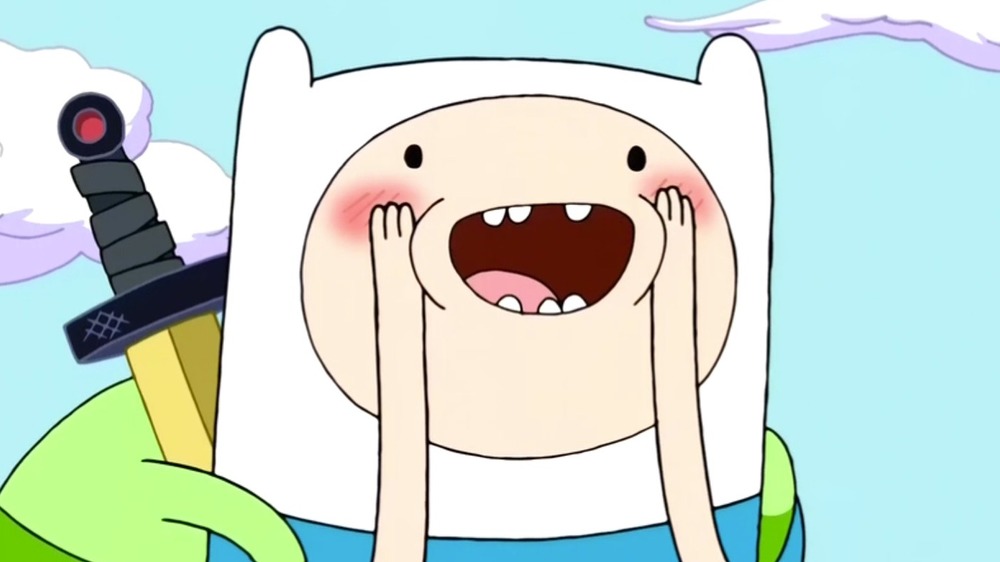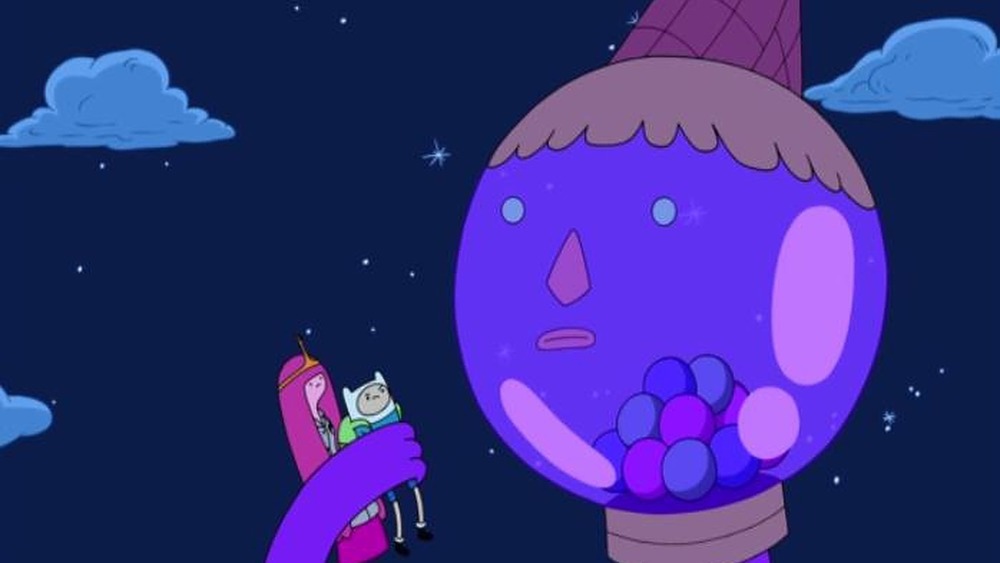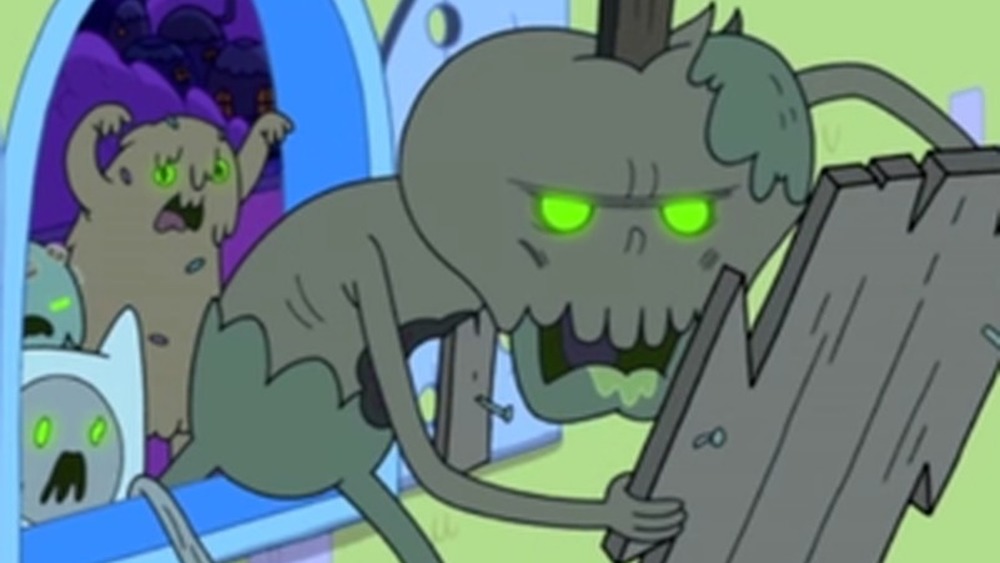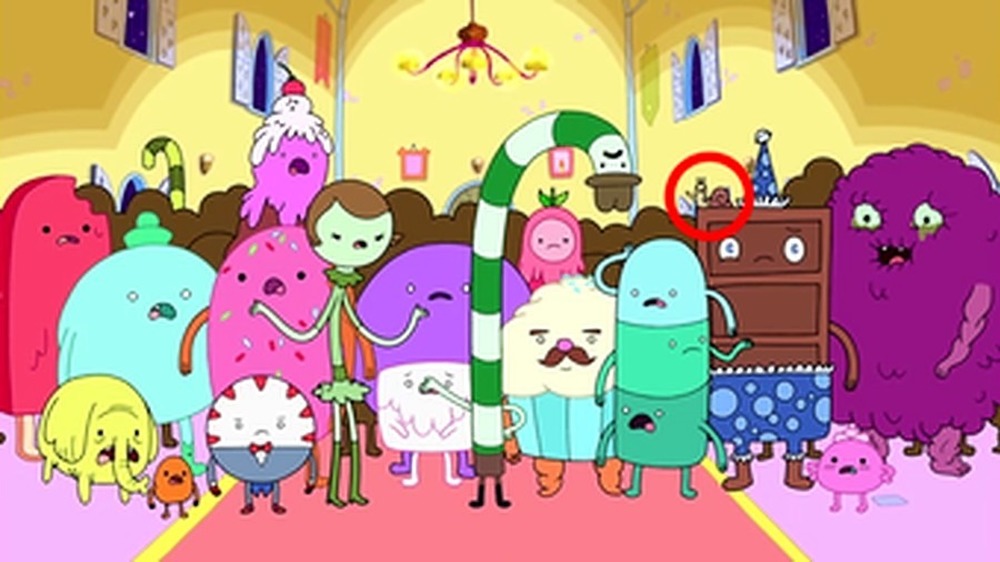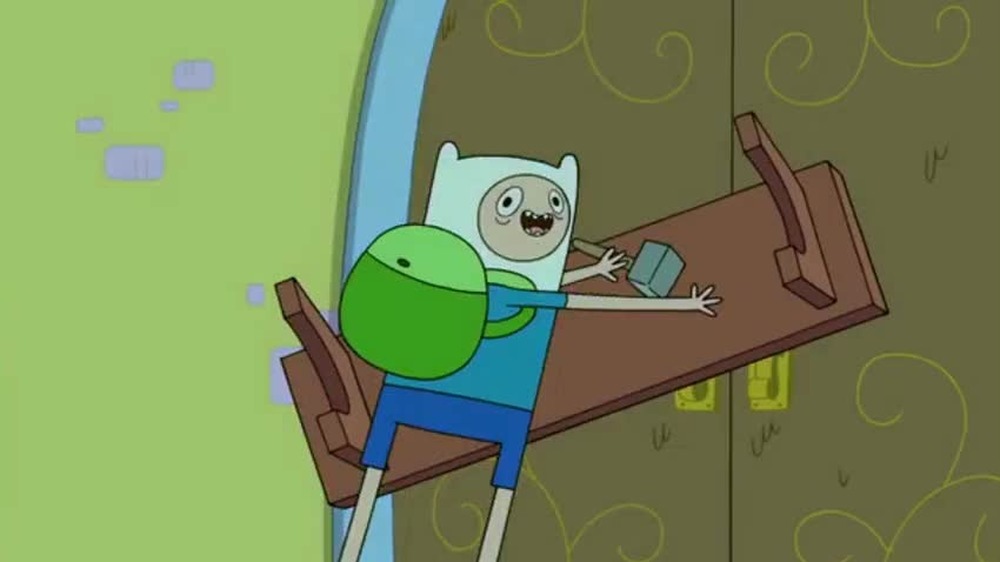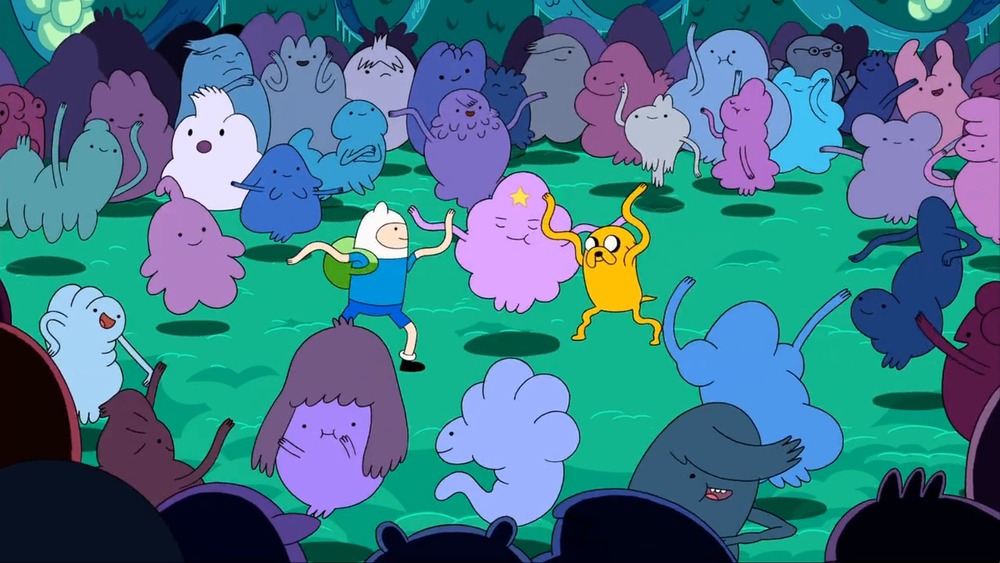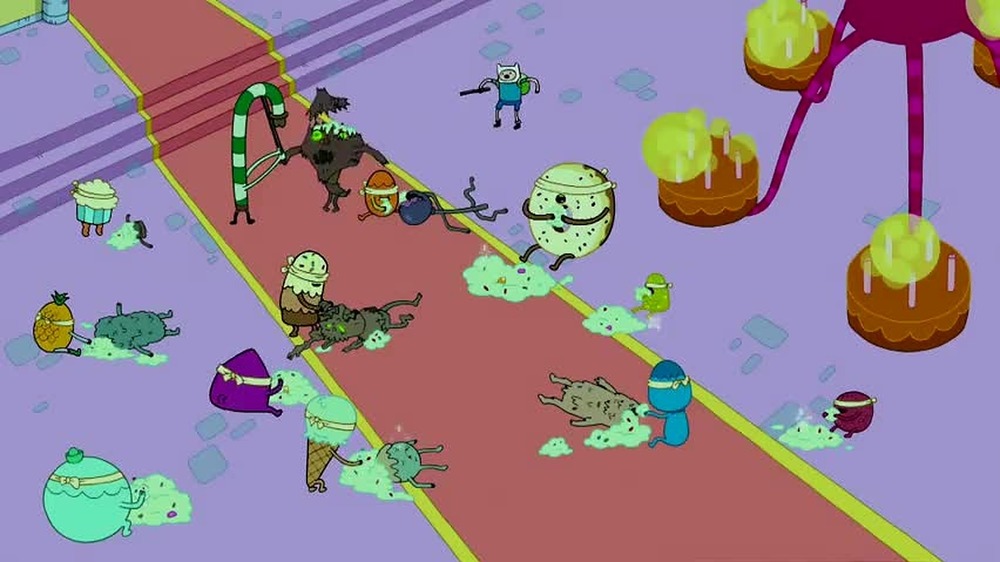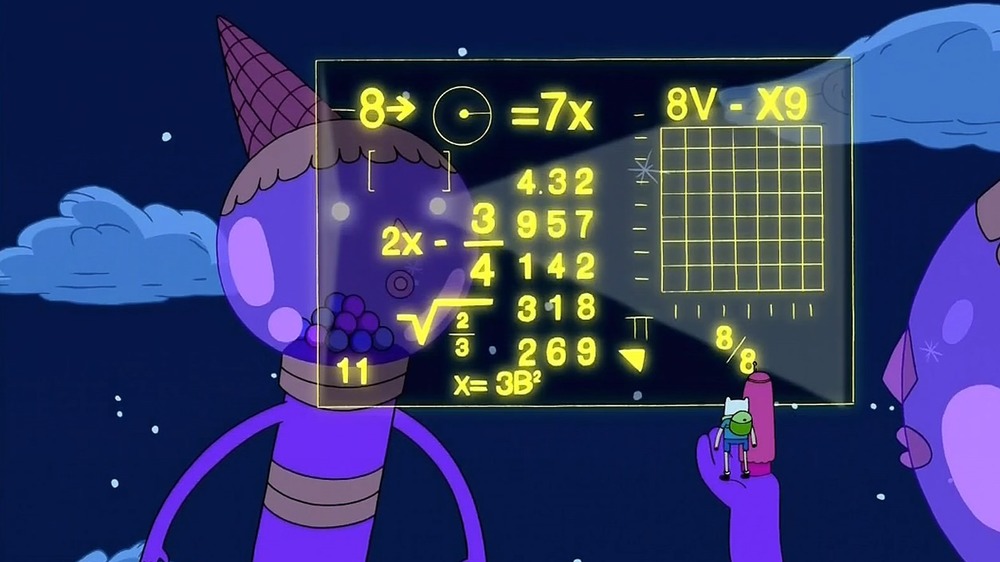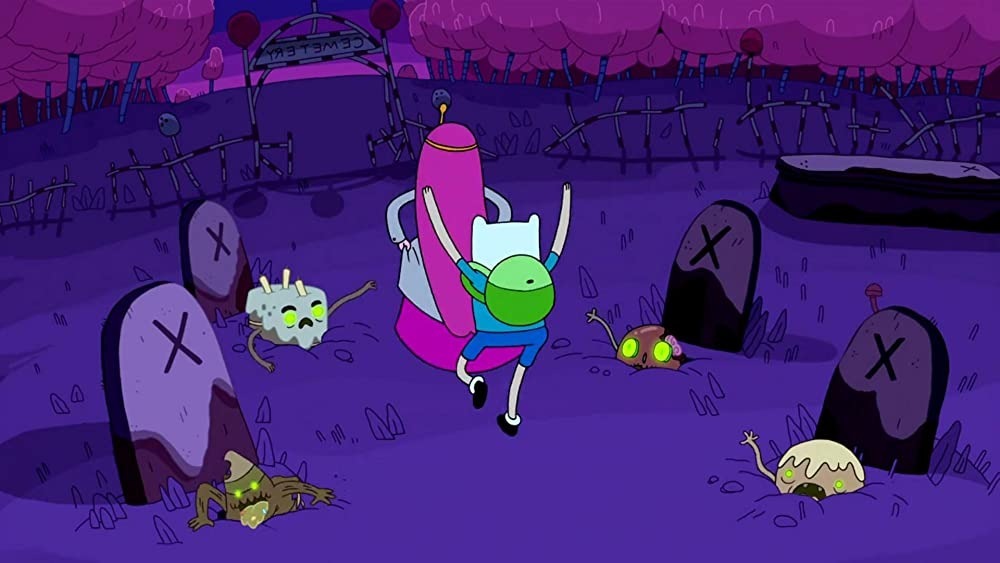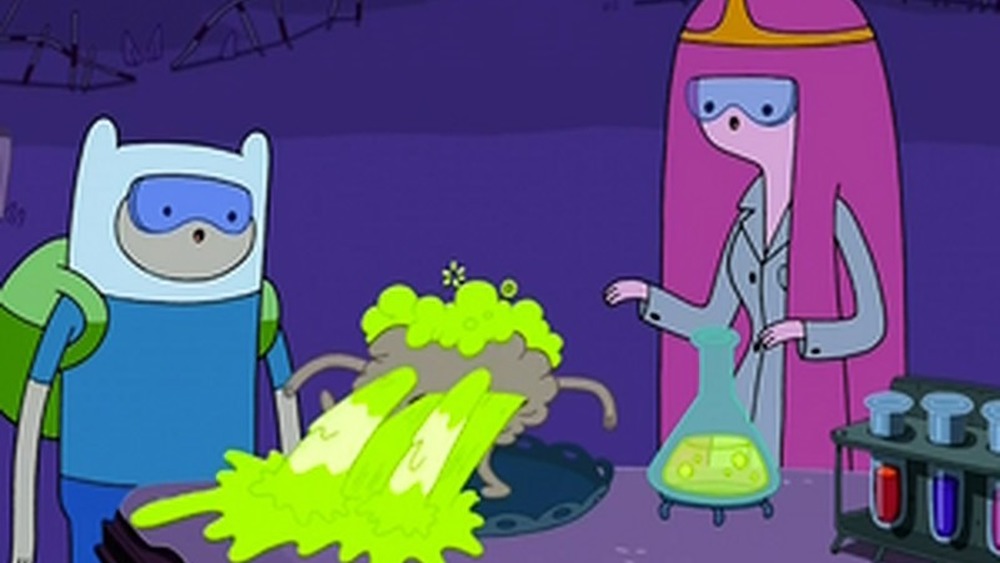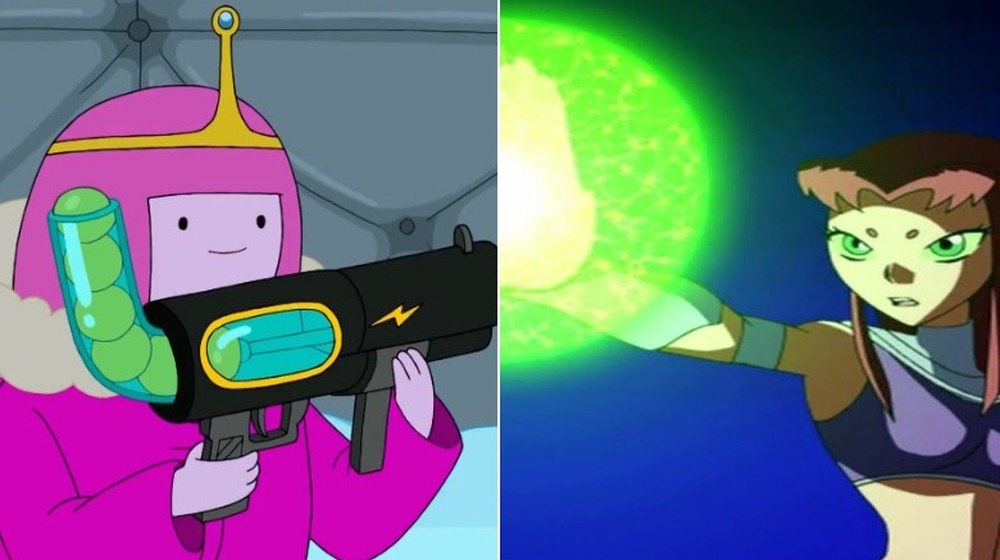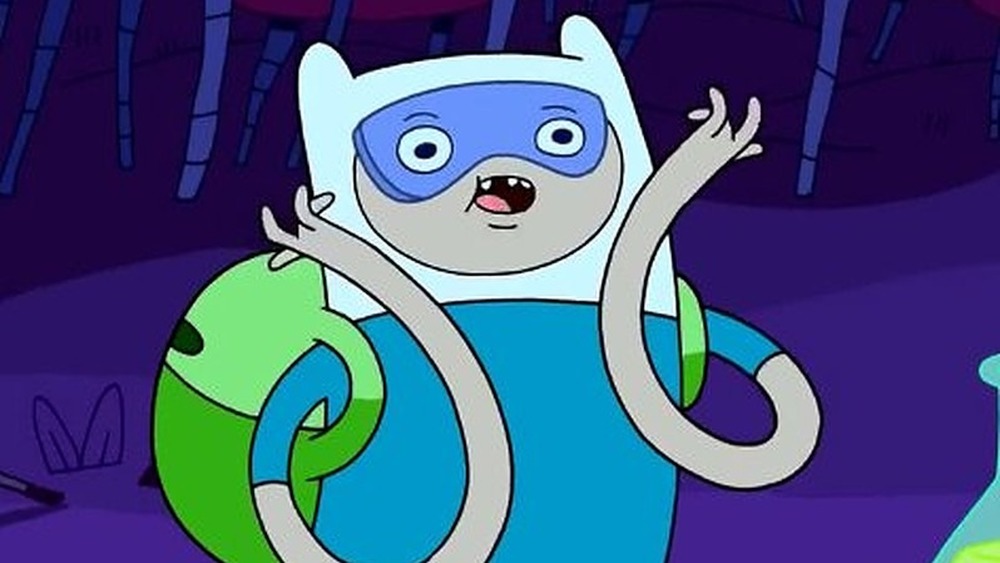Things You Never Noticed In The First Adventure Time Episode
From 2010 to 2018, audiences all over the world went along with Jake the Dog and Finn the Human on their wild adventures in the Land of Ooo, the fictional world that houses Cartoon Network's popular animated series Adventure Time. From the very first episode, which for our purposes will include April 5, 2010's joint half-hour premiere composed of both "Slumber Party Panic" and "Trouble in Lumpy Space," we are introduced to a color-saturated cast of profound and expressive characters from all walks of life and death.
If you're a huge fan of Adventure Time, the first episode is probably pretty familiar to you. If you've watched it more than a few times, you probably began to notice new things each time. But there may have been a few things that you missed, if you didn't take the time to view them from a different angle or for a second time. There may have been a few details and allusions that seemed familiar and unassuming, but were just waiting to be looked at in a different way.
When Marceline the 1,000-year-old vampire queen doesn't want to fall asleep because she wants to avoid the strange dreams she's been having, her mother consoles her, telling her that maybe they aren't as strange as she thinks: "Something weird might just be something familiar viewed from a different angle." So let's take that first episode of Adventure Time and make it weird (by Marceline's mother's definition, anyway).
The Guardians of the Royal Promise
The Guardians of the Royal Promise are only called that in "Slumber Party Panic," when they enforce Finn's promise to Princess Bubblegum after Finn unwittingly breaks it. After this episode, though, the Royal Promise doesn't really come up again, and so the Guardians are quietly rebranded (or de-branded). Following the first episode, they are known simply as the Gumball Guardians, an alliterative nod to their species. (Their purpose is to protect the kingdom, but it's worth noting that when the Candy People are hurrying to the castle to flee the zombies, the Guardians just sit there blowing bubbles.)
You can see them in many episodes (including the first, before their role is announced) blowing bubbles on either side of the Candy Castle, but you may not have caught the miniature model of a Gumball Guardian that Princess Bubblegum has in her lab. Since it was Princess Bubblegum who actually created the Gumball Guardians to protect her kingdom, it makes sense to see a smaller model in her lab, perhaps an early prototype or a miniature adaptation for personal use.
But it's an interesting lapse to note that despite creating them herself, Bubblegum doesn't seem to know that a math problem can serve as an alternative form of justice to the Guardians' typically prescribed trial by fire. (Or maybe she just thought that Finn was so bad at math that he'd fare better in the flames.)
Finn the Zombie
The premise of "Slumber Party Panic" revolves around zombie candy people who have been revived (but only partly) by Princess Bubblegum's "decorpsinator" serum. All of the zombies come from the cemetery where deceased Candy People have been buried. One of them is Princess Bubblegum's old boyfriend, Old Mr. Creampuff.
There is little evidence that the zombies bite other people and turn them into zombies. We do know they eat Candy People, but the main danger to the Candy People other than getting eaten is their own propensity for exploding due to fear at the sight of the monsters.
So what we don't know is why there's a Zombie Finn among the ranks of the undead. You can see him climbing in through the window briefly at 7:54. Finn hasn't died and was already in the castle, so he certainly can't be undead outside of the castle. Zombie Finn is never mentioned or used for the plot, so maybe he is just a funny little detail the animators decided to throw in.
Or perhaps it's another one of Princess Bubblegum's failed experiments, a clone of her friend that she buried long ago? Either way, the Zombie Finn is unmistakable in Finn's trademark white hat, but instead of rounded tips, the more sinister form of Finn has a hat with pointed ones.
The rules of Lumpiness
Lumpy Space Princess says in "Trouble in Lumpy Space" that after a bite from a Lumpy Space Person, it's basically "werewolf rules," since Jake has until sundown to get the antidote. Of course, not all werewolf rules apply, since the Lumpy Space People are lumpy all the time, rather than transforming from human to lump at the full moon.
However, the Lumpy Space People do transform: By the power of the antidote, they can change into human teenagers. Following from "werewolf rules," the orb that contains the antidote resembles the moon, which is also the impetus for werewolves to change states. In fact, if we look at the antidote orb as reminiscent of the moon, then Lumpy Space rules are still related to werewolf rules in the sense that they are the exact opposite: They become human with the full moon.
One thing we notice on a second pass but can't totally explain is that Finn's backpack seems to disappear when he becomes Lumpy, and we don't know what this might mean in the logistics of transformation.
Hidden snail
Almost every single episode features a hidden snail, usually waving at the audience. You may not have noticed it the first time you saw the inaugural episode, only coming back to check once it became a continuing joke. The first-ever hidden snail can be found on top of a Candy Person's head in the crowd at 6:50! The snail makes its second appearance at 9:49 in "Trouble in Lumpy Space."
The running gag became extremely popular with fans, and after more than 50 episodes, it went from a visual joke to a crucial part of the plot: In "Mortal Folly," the Lich possesses the snail as it emerges to wave at the audience, using it to break the amber prison that contains him. Cartoon Network made a compilation entitled "Every Snail Ever" that features the snail from each episode along with fans young and old waving at and greeting the snail through their cameras. One dedicated Redditor even crocheted a replica of the hidden snail.
Seeing it in fabric form was the first time one commenter realized that the animators had put the eyes on the snail's head near the mouth, rather than at the ends of its stalks where they belong. But another commenter suggested that the eyes' location wasn't an accident, but rather a mutation brought on by the fallout from the Great Mushroom War — an excellent, if non-canonical, explanation.
The Blockado game
The game of Blockado basically involves pushing objects against doors and windows to prevent zombies from getting in. There is one hammer involved, which Finn uses to hammer a bench across the Candy Castle doors, but he doesn't use any nails to secure it. Regardless, the bench stays in place, as do the other objects the Candy People use to barricade the entrances and doors, despite using neither hammers nor nails.
Finn hastily and nervously announces his game as "Blockado...The Game of Barricades!" when the Chocolate-Covered Strawberry asks what game he's playing now as he rushes to block the entrances. This is a reference to the way that board game companies commonly approached marketing, as in the cases of Sorry: The Game of Sweet Revenge; Risk: The Game of Global Domination; and Taboo: The Game of Unspeakable Fun.
Also worth remarking upon? During the game of Blockado, Starchy is seen playing, despite having exploded earlier from fear when he sees a zombie in the cemetery (an example for the audience of what happens when a Candy Person gets scared). We know he met his demise and couldn't possibly have been among the Candy People playing Blockado, because he needed to be decorpsinated later.
Indications of Lumpy Space Person culture
Lumpy Space Person culture is ostensibly complicated and pretty difficult to pin down, in no small part because of how inaccessible the Lumpy Space People are themselves. Their personalities are abrasive and difficult, as they are essentially modeled after petulant teenagers. The Lumpy Space People are portrayed as constantly irritable, moody, and capricious, with concerns that mirror those of caricatured high school girls: texting, school dances, fights with parents, and guys named Brad.
In "Trouble in Lumpy Space," there's a lot of drama in just about every area surrounding the promcoming dance. Yep, you read that right: Promcoming. As in, homecoming combined with prom. Must be the biggest event of the year, right? Nope. Though the histrionic Lumpy Space People certainly act like it's the beginning and end of the world, promcoming isn't just a once- or twice-a-year ordeal like American proms and homecomings. With all the drama, you'd almost miss the casually mentioned fact that it's a weekly event. The culture of Lumpy Space truly does revolve, 24/7, around high-school-type concerns.
Candy Castle details
The Candy Castle in Princess Bubblegum's Candy Kingdom is truly a wonder to behold. She created the entire Candy Kingdom from scratch (including all of the Candy People), and you can tell that a lot of love and ingenuity went into each and every element of this world. Indeed, Bubblegum created the first Candy People because she was lonely and wanted more family than just her brother Neddy.
The details of the Candy Castle are more involved than simple background features. For example, the ice cream cone sconces on the walls, which replace the candles or torches that would normally be expected in the halls of a castle, are a creative enough addition already, given the similar shape of ice cream cones to flaming torches. But even more inventive and detail-oriented is the fact that the ice cream cone sconces are halfway melted!
It's as if they really have been burning all day — or at the very least, suggests that Bubblegum takes the care to add a new scoop every day after the old one has melted. You can also see in one aerial shot that each leg of the chandelier in the hall contains not just a candle or set of candles, but an entire birthday cake with candles on it.
Math and meaning
It's common knowledge that throughout the series, Finn uses math-related words to express enthusiasm, saying, "Algebraic!" or "Mathematical!" where someone else might say something like "Awesome!" This is just one example of the many quotable elements of Adventure Time on display from its very inception.
But what is funny about this is that Finn is actually, as Princess Bubblegum informs us, terrible at math. This is why she wonders at his decision to choose a math question as his trial before the Guardians of the Royal Promise. (They first give him an impossible-looking problem, then think of a "better one," which is 2+2. And even with such a simple question, Finn doesn't sound entirely sure of his answer.)
Finn's use of math words to express positive sentiments, despite math being a problem area for him, is a subtle indication of the true height of his optimism. It is a quiet foreshadowing of the fact that Finn can be recklessly idealistic to the point of naivete, leading to him sometimes having trouble initially when facing problems he can't immediately fix, his own personal failings or troublesome memories and conflicts — especially those in which positions of good and evil aren't cut and dried. Finn's blind idealism can get him into trouble, but also makes him a fearsome hero, and we get our first inkling of it in his mathematical interjections.
Swordplay is second only to wordplay
Speaking of the quotability of Adventure Time, there's even more wordplay in the first episode than you'd notice the first time around. After being turned into a Lumpy Space Person and then reversed, Finn apologizes to Lumpy Space Princess for "blowing up" at her before, a reference to how he literally blew up to a massive size. And when the zombies begin to rise from their graves and Finn must fight them back, Finn says, "You're grounded" after he pushes a zombie back into the ground, and tells another member of the undead to "get a life."
The wordplay that occurs just about every other line in this episode sets the tone for a lot of puns that will continue to pepper the show. Along with Finn's odd interjections, the very first episode leads us to understand words not necessarily by their definitions, but by the emotions behind them and the situations they're used in.
Ultimately, these practices, however inconsequential and even nonsensical they may seem, lead us to view Adventure Time, and maybe the world, through a more empathetic lens. By shirking the meanings we typically attach to words, Adventure Time prompts us to look for the real meaning in the people who say them.
Four for one
One of the best instances of wordplay, though, is a whopping quadruple entendre. When Princess Bubblegum turns Old Mr. Creampuff (whom she used to date) into a zombie and he tries to bite her, he says in a sing-songy voice as he clings to her leg, "Gimme some sugar, baby."
This line, innocuous as it sounds, has no fewer than four meanings. The first is pretty obvious: Old Mr. Creampuff is a Candy Zombie, and Princess Bubblegum is a Candy Person and therefore made of sugar, so he wanted to eat her. He literally wanted her to give her some sugar. The second interpretation revolves around the fact that they used to date, so you can also take his phrase suggestively or flirtatiously, as if he was asking his former girlfriend for affection with an endearing pet name.
A less-known association of the phrase, though, is the fact that it's a line from the movie Army of Darkness, which focuses on the undead: Mr. Creampuff is undead in this episode, and it revolves around dealing with a zombie army. Finally, Mr. Creampuff lives in the Candy Kingdom, where anything can be and usually is a reference to candy. When he says, "Give me some sugar, baby," we're reminded that "Sugar Babies" are themselves a kind of candy.
Walch your tongue
Fans who have been watching high-concept cartoons for a while might have noticed something familiar the very first time they watched Adventure Time, or maybe it would have taken them a couple episodes to pin down. It's not something you notice visually, but rather, a sound: Princess Bubblegum is voiced by the same actress who voiced Starfire on Teen Titans. She also reprises her role on the current Cartoon Network follow-up series Teen Titans GO!
Hynden Walch's voice has an incredibly recognizable soft, light timbre that makes her a wonderful voice actress. And these two roles in particular both fit her delicate but clear voice very well, in addition to having a number of similarities between them. Starfire also had pinkish-red hair and was very innocent, just like Bubblegum as the pure-hearted leader of a race of sweet, gentle Candy People. (Her solution to a zombie outbreak is to throw a slumber party, and honestly, that seems like something Starfire would do.)
Finn's ambidexterity
It has been suggested that Finn is ambidextrous. According to the Adventure Time Encyclopaedia, which was written by Martin Olson from the perspective of Marceline's father, the Lord of Evil (whom Olson voiced), Finn is in fact left-handed. (Knowing this, losing his right arm multiple times doesn't seem like as big of a deal.)
However, many people who were born with one hand dominant have developed a certain level of ambidexterity when situations call for it. Finn's frenetic heroism, which requires everything from rapid writing to expert swordsmanship, certainly calls for it.
And we can really see it on display in this episode. With his right hand, Finn picks up a platter with a deceased Mr. Creampuff on it (removing the lid with his left). He also grabs and holds up a stick in a rallying cry with his right hand, as well as using it to beat back zombies with a right-handed batting stance. With his left hand, though, he pushes a zombie into the grave, throws his sock, turns on the radio, and wields a hammer to build the blockade. Clearly, no matter which hand is technically dominant, Finn is an excellent and versatile warrior.
